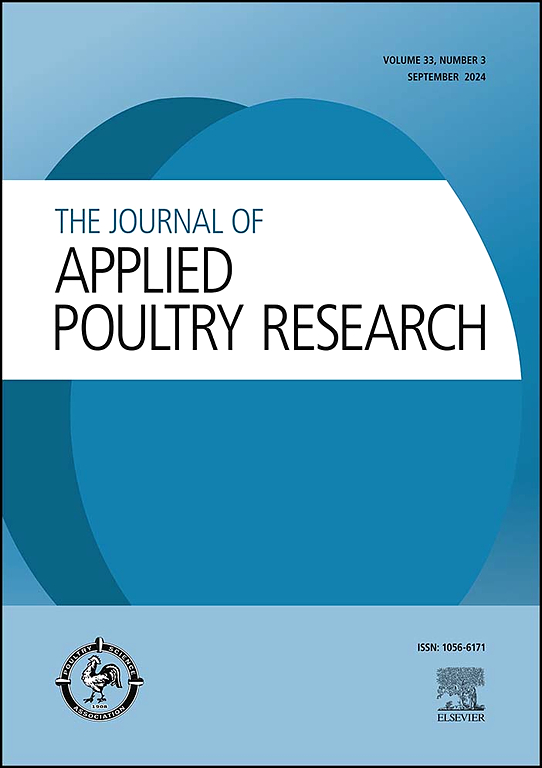The effect of laying hen strain on perching biomechanics and keel deviations
IF 2
3区 农林科学
Q2 AGRICULTURE, DAIRY & ANIMAL SCIENCE
引用次数: 0
Abstract
Keel bone damage (KBD), including deviations and fractures, is a welfare concern in laying hens leading to pain and decreased egg production. Shifting towards alternative housing systems has highlighted a need to evaluate how laying hen strain and perch shape contributes to perching biomechanics and KBD. Our study aimed to determine the effect of strain on perching biomechanics, keel deviations, body weight, and bone composition. Four commercial strains (Lohmann White, Shaver White, Lohmann Brown, ISA Brown) and two random-bred strains (Shaver Rhode Island Red and Antique White Leghorn) were studied (n = 20/treatment). Perching kinematics were evaluated on round and mushroom-shaped perches at 18, 29, and 70 weeks of age using continuous kinematic recordings. Instability indicators while perching included movement speed and motion in the x- (side-side), y- (forward-backward), and z-axes (up-down). Dual x-ray absorptiometry was used to assess bone parameters (femur and keel bone mineral content and density). Keel deviation severity was assessed via digital imaging post-mortem. Rhode Island Red hens had greater femur bone mineral density and content compared with all other strains evaluated. Higher-producing commercial strains had more incidences of severe keel deviations. Round perches led to faster forward-backward and up-down movements compared to mushroom perches. Commercial strains moved up-down more and forward-backward less than random-bred strains. Up-down movements were correlated with higher incidences of severe keel deviations. Overall, both strain and perch shape effected perching biomechanics. Specifically, round perches contributed to instability while perching. Commercial strains with more severe keel deviations moved up-down more than random-bred strains.
蛋鸡应变对栖息生物力学和龙骨偏差的影响
龙骨损伤(KBD),包括偏差和骨折,是蛋鸡福利方面的一个问题,会导致疼痛和产蛋量下降。向替代饲养系统的转变凸显了评估蛋鸡应变和栖架形状如何影响栖架生物力学和KBD的必要性。我们的研究旨在确定应变对栖息生物力学、龙骨偏差、体重和骨骼组成的影响。研究了四个商品品系(Lohmann White、Shaver White、Lohmann Brown、ISA Brown)和两个随机饲养品系(Shaver Rhode Island Red和Antique White Leghorn)(n = 20/处理)。在 18、29 和 70 周龄时,在圆形和蘑菇形栖木上使用连续运动学记录对栖木运动学进行评估。栖息时的不稳定性指标包括移动速度和X轴(侧面)、Y轴(前后)和Z轴(上下)的运动。双 X 射线吸收测量法用于评估骨骼参数(股骨和龙骨的骨矿物质含量和密度)。龙骨偏差的严重程度通过死后数字成像进行评估。与评估的所有其他品系相比,罗德岛红母鸡的股骨骨矿物质密度和含量更高。产量较高的商品品系出现严重龙骨偏差的几率更高。与蘑菇栖架相比,圆形栖架的前后移动和上下移动更快。与随机培育的品系相比,商品品系的上下运动更多,前后运动更少。上下运动与龙骨严重偏差发生率较高有关。总的来说,菌株和栖木形状都会影响栖木生物力学。具体来说,圆形栖木会导致栖木不稳定。与随机培育的品系相比,龙骨偏离更严重的商品品系的上下运动更多。
本文章由计算机程序翻译,如有差异,请以英文原文为准。
求助全文
约1分钟内获得全文
求助全文
来源期刊

Journal of Applied Poultry Research
农林科学-奶制品与动物科学
CiteScore
4.10
自引率
10.50%
发文量
80
审稿时长
104 days
期刊介绍:
The Journal of Applied Poultry Research (JAPR) publishes original research reports, field reports, and reviews on breeding, hatching, health and disease, layer management, meat bird processing and products, meat bird management, microbiology, food safety, nutrition, environment, sanitation, welfare, and economics. As of January 2020, JAPR will become an Open Access journal with no subscription charges, meaning authors who publish here can make their research immediately, permanently, and freely accessible worldwide while retaining copyright to their work. Papers submitted for publication after October 1, 2019 will be published as Open Access papers.
The readers of JAPR are in education, extension, industry, and government, including research, teaching, administration, veterinary medicine, management, production, quality assurance, product development, and technical services. Nutritionists, breeder flock supervisors, production managers, microbiologists, laboratory personnel, food safety and sanitation managers, poultry processing managers, feed manufacturers, and egg producers use JAPR to keep up with current applied poultry research.
 求助内容:
求助内容: 应助结果提醒方式:
应助结果提醒方式:


